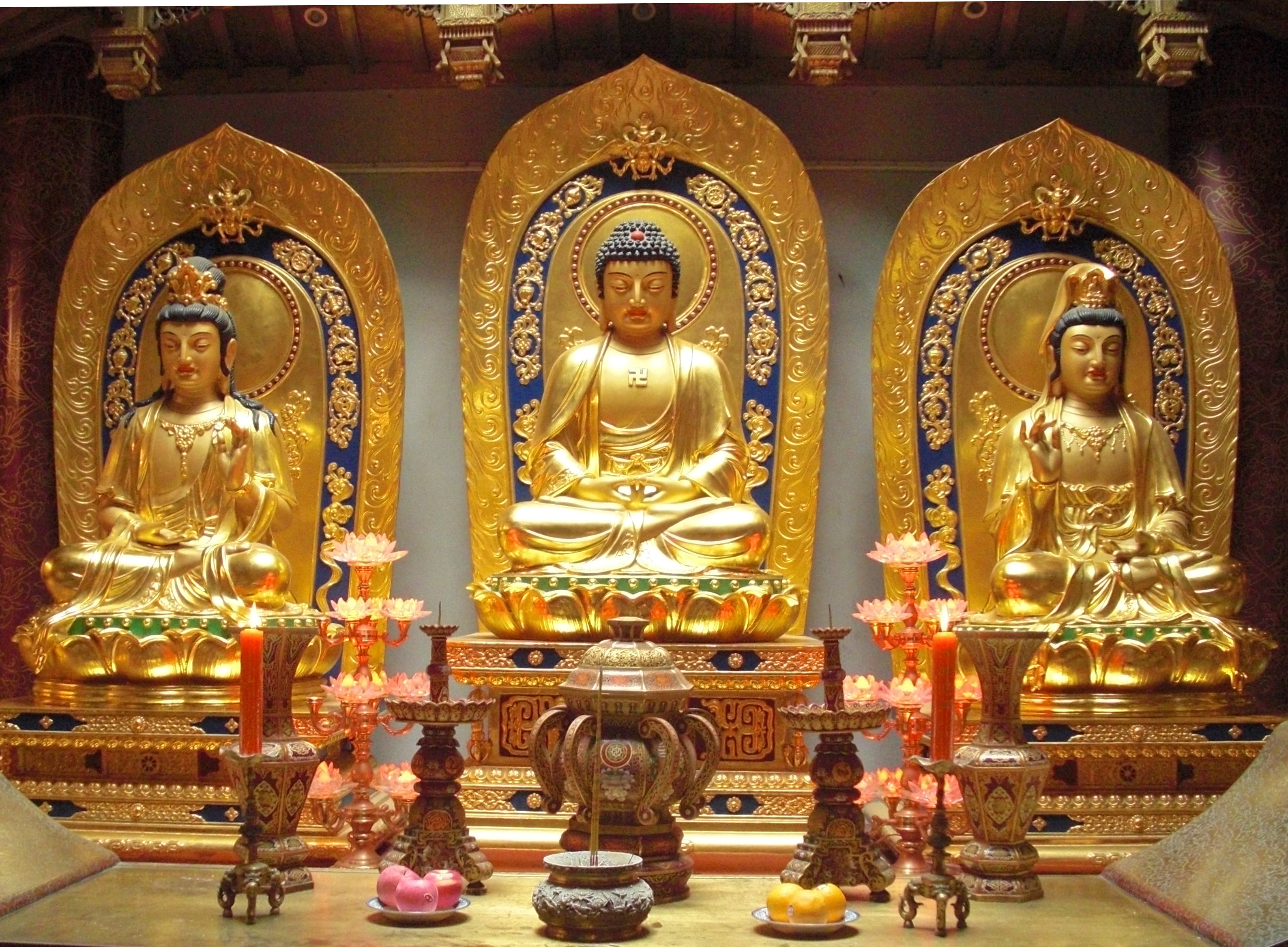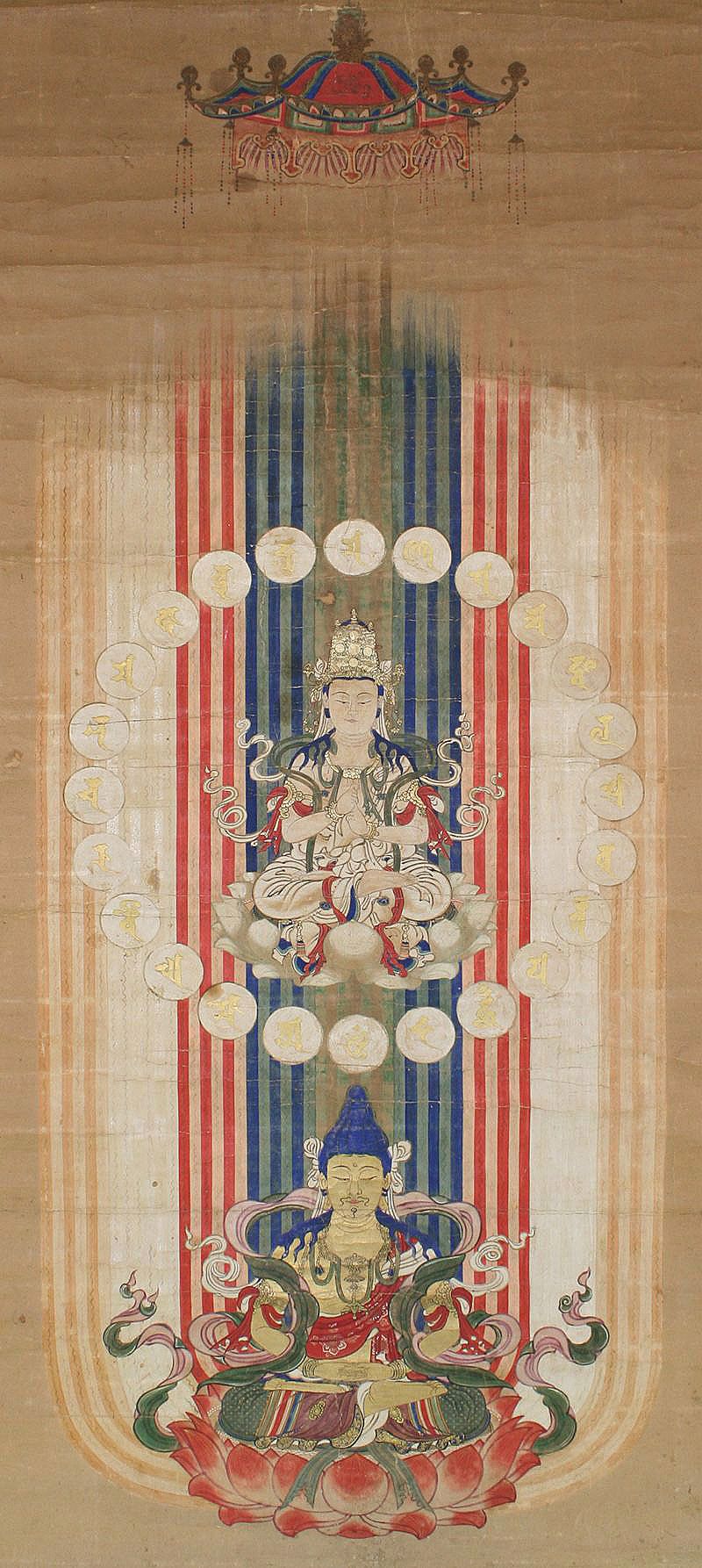|
┼īj┼Ź
The term ┼īj┼Ź () is a term in Japanese Buddhism for rebirth in the Pure Land of Amitabha Buddha. Sometimes the term is expressed as . The subject of how to obtain birth in the Pure Land remained an important question throughout Japanese Buddhist history even until today. The Nara Schools The early Nara Buddhism schools provided different opinions as to how to obtain rebirth in the Pure Land, though in some cases, such as the Hoss┼Ź school taught that icchantikas (people who committed the Five Grave Acts) could not obtain rebirth ever. Other schools taught that while accessible to all, the rituals involved were difficult, or that rebirth was not desirable. Tendai and Shingon Early sects, particularly the Tendai and Shingon sects relied on esoteric texts, or interpretations of the Contemplation Sutra to develop rituals and visualizations of rebirth in the Pure Land. Genshin, a Tendai monk, wrote the ''┼īj┼Źy┼Źsh┼½'' in which he described the horrors of Hell in Buddhis ... [...More Info...] [...Related Items...] OR: [Wikipedia] [Google] [Baidu] |
Genshin
, also known as , was a prominent Japanese monk of the Tendai school, recognized for his significant contributions to both Tendai and Pure Land Buddhism. Genshin studied under Ry┼Źgen, a key reformer of the Tendai tradition, and became well known for his intellectual prowess, particularly after his success in a major debate at Mount Hiei in 974. Genshin spent much of his later life at the secluded Eshin-in monastery in Yokawa on Mount Hiei, where he focused on scholarly pursuits and meditation. He is credited with founding the Eshin school of Tendai, which emphasized the idea of inherent awakening (Original enlightenment, hongaku). Although deeply rooted in Tendai teachings, Genshin became a leading figure in the early development of Pure Land Buddhism. His most influential work, ''┼īj┼Źy┼Źsh┼½'' (ÕŠĆńö¤Ķ”üķøå, ''Collection of the Essentials for Birth''), outlined a comprehensive approach to attaining Rebirth (Buddhism), rebirth in Amit─übha, Amitabha's Pure Land, integrating ... [...More Info...] [...Related Items...] OR: [Wikipedia] [Google] [Baidu] |
┼īj┼Źy┼Źsh┼½
The was an influential medieval Buddhism, Buddhist text composed in 985 by the Japanese Buddhist monk Genshin. The text is a comprehensive analysis of Buddhist practices related to rebirth in the Pure Land of Amit─übha, Amida Buddha, drawing upon earlier Buddhist texts from China, and sutras such as the Contemplation Sutra. Genshin advocated a collection of mutually supportive practices, such as sutra recitation, centered around visual meditation of Amitabha Buddha where later Pure Land sects favored an approach that relied on exclusive recitation of the verbal ''nembutsu''. The text is also well known for its graphic descriptions of the Naraka (Buddhism), Hell realms, and sufferings one might endure for harmful acts committed in this life. Its influence can be seen in Japanese Buddhist paintings and other, later, texts. The founder of Jodo Shinshu, J┼Źdo Shinsh┼½ Buddhism, Shinran, wrote an influential commentary on the ''┼īj┼Źy┼Źsh┼½'' titled, "Notes on Essentials of Rebirth", ... [...More Info...] [...Related Items...] OR: [Wikipedia] [Google] [Baidu] |
Tendai
, also known as the Tendai Dharma Flower School (Õż®ÕÅ░µ│ĢĶŻիŚ, ''Tendai hokke sh┼½,'' sometimes just ''Hokkesh┼½''), is a Mah─üy─üna Buddhist tradition with significant esoteric elements that was officially established in Japan in 806 by the Japanese monk Saich┼Ź. The Tendai school, which has been based on Mount Hiei since its inception, rose to prominence during the Heian period (794ŌĆō1185). It gradually eclipsed the powerful Hoss┼Ź school and competed with the rival Shingon school to become the most influential sect at the Imperial court. By the Kamakura period (1185ŌĆō1333), Tendai had become one of the dominant forms of Japanese Buddhism, with numerous temples and vast landholdings. During the Kamakura period, various monks left Tendai to found new Buddhist schools such as J┼Źdo-sh┼½, J┼Źdo Shinsh┼½, Nichiren-sh┼½ and S┼Źt┼Ź Zen. The destruction of the head temple of Enryaku-ji by Oda Nobunaga in 1571, as well as the geographic shift of the capital away from ... [...More Info...] [...Related Items...] OR: [Wikipedia] [Google] [Baidu] |
Pure Land Buddhism
Pure Land Buddhism or the Pure Land School ( zh, c=µĘ©Õ£¤Õ«Ś, p=J├¼ngtŪöz┼Źng) is a broad branch of Mahayana, Mahayana Buddhism focused on achieving rebirth in a Pure land, Pure Land. It is one of the most widely practiced traditions of East Asian Buddhism, Buddhism in East Asia. It is also known as the "Lotus School" (Chinese language, Chinese: Ķō«Õ«Ś; pinyin: ''Li├Īnz┼Źng'') in China or the "Nianfo, Nembutsu school" in Japan. East Asian Pure Land mainly relies on three main Mahayana sutras, Mahayana scriptures: the ''Longer Sukh─üvat─½vy┼½ha S┼½tra, Sutra of Amitayus'', the ''Amit─üyus Contemplation S┼½tra, Contemplation Sutra'' and the ''Shorter Sukh─üvat─½vy┼½ha S┼½tra, Amitabha Sutra''. The Pure Land tradition is primarily focused on achieving rebirth in a Buddhahood, Buddha's "pure land", a superior place to spiritually train for full Buddhahood, where one can meet a Buddha face to face and study under them without any of the distractions or fears of our world.Williams, Pau ... [...More Info...] [...Related Items...] OR: [Wikipedia] [Google] [Baidu] |
Nembutsu
file:ńÄēķćīĶÅ»Õ▒▒Õ»║ (21)ÕŹŚńäĪķś┐ÕĮīķÖĆõĮøÕÅżńóæ.jpg, 250px, Chinese Nianfo carving The Nianfo ( zh, t=wikt:Õ┐ĄõĮø, Õ┐ĄõĮø, p=ni├Ānf├│, alternatively in Japanese language, Japanese ; ; or ) is a Buddhist practice central to East Asian Buddhism. The Chinese term ''nianfo'' is a translation of Sanskrit ''Buddh─ünusmß╣øti, '' ("recollection of the Buddhahood, Buddha"), a classic Buddhist Sati (Buddhism), mindfulness (smß╣øti) practice. Nianfo focused on the Buddha Amit─übha is also the most important practice in Pure Land Buddhism. In the context of East Asian Pure Land practice, nianfo typically refers to the oral repetition of the name of Amit─übha through the phrase "Homage to Amitabha Buddha" (Chinese language, Ch: ÕŹŚńäĪķś┐ÕĮīķÖĆõĮø, Mandarin Chinese, Mandarin: N─üm├│ ─Ćm├Łtu├│f├│, Japanese language, Jp: Namu Amida Butsu; from the Sanskrit: Namo'mit─übh─üya Buddh─üya). It can also refer to that phrase itself, in which case it may also be called ''the'' nianfo, or "The Name" (Ja ... [...More Info...] [...Related Items...] OR: [Wikipedia] [Google] [Baidu] |
Hell In Buddhism
''Naraka'' (; zh, t=Õ£░ńŹä’╝ÅÕźłĶÉĮ, p=D├¼y├╣/N├Āilu├▓; ) is a term in Buddhist cosmology usually referred to in English as "hell" (or "hell realm") or "purgatory". Another term used for the concept of hell in earlier writings is ''niraya''. In Cambodia, Naraka was part of Buddhist cosmology and indeed also a Khmer word (ß×ōß×Üß×Ć; norok) for hell. The Narakas of Buddhism are closely related to ''Diyu'', the hell in Chinese mythology. A ''naraka'' differs from the concept of hell in Christianity in two respects: firstly, beings are not sent to Naraka as the result of a divine judgment or punishment; secondly, the length of a being's stay in a ''naraka'' is not eternal, though it is usually incomprehensibly long. A being is born into ''naraka'' as a direct result of its accumulated actions (karma) and resides there for a finite period of time until that karma has achieved its full result. After its karma is used up, it will be reborn in one of the higher worlds as the result o ... [...More Info...] [...Related Items...] OR: [Wikipedia] [Google] [Baidu] |
Mapp┼Ź
The Decline of the Dharma or Ages of the Dharma, refers to traditional Buddhist accounts of how the Buddhism, Buddhist religion and the Buddha's teaching (Dharma) is believed to decline throughout history. It constitutes a key aspect of Buddhist eschatology and provides a Social cycle theory, cyclical model of history, beginning with a virtuous age where spiritual practice is very fruitful and ending with an age of strife, in which Buddhism is eventually totally forgotten. Buddhist accounts of this process culminate in the eventual arrival of a new Buddhahood, Buddha, Maitreya. There are various accounts of this process of Dharma decline, which begins with Shakyamuni Buddha's death and continues throughout the generations as society and its knowledge of the Buddha's teachings decline over the centuries. Ages of the Dharma There are different accounts of the decline of the Buddha's teaching (Buddha Dharma), i.e. Buddhism. These Buddhist accounts of longue dur├®e history and Buddh ... [...More Info...] [...Related Items...] OR: [Wikipedia] [Google] [Baidu] |
H┼Źnen
, also known as Genk┼½, was the founding figure of the , the first independent branch of Japanese Pure Land Buddhism. H┼Źnen became a Tendai initiate at an early age, but grew disaffected and sought an approach to Buddhism that all people of all classes and genders could follow, even during the current Three Ages of Buddhism, Age of Dharma Decline. After reading Shandao's Commentary on the ''Amit─üyus Contemplation S┼½tra'', H┼Źnen devoted himself to attaining birth in the pure land of Amit─übha Buddha (Amida) through the practice of "recitation of the Buddha's name" (Jp: Nianfo, nembutsu) and to spreading this teaching among all people. H┼Źnen gathered a wide array of followers and attracted numerous critics. He taught them all the simple practice of reciting "Namo Amida Butsu" while entrusting oneself to Amida's universal Other power, vow power.Hirota, Dennis,Japanese Pure Land Philosophy, ''The Stanford Encyclopedia of Philosophy'' (Fall 2022 Edition), Edward N. Zalta & Uri N ... [...More Info...] [...Related Items...] OR: [Wikipedia] [Google] [Baidu] |
Icchantikas
In Mahayana Buddhism the ''icchantika'' (õĖĆķŚĪµÅÉ) is an incorrigible unbeliever who lacks faith in Buddhism and has no prospect of attaining enlightenment. Description According to some Mahayana Buddhist scriptures, the ''icchantika'' is the most base and spiritually deluded of all types of being. The term implies being given over to total hedonism and greed. In the Tathagatagarbha sutras, some of which pay particular attention to the ''icchantikas'', the term is frequently used of those persons who do not believe in the Buddha, his eternal Selfhood and his Dharma (Truth) or in karma; who seriously transgress against the Buddhist moral codes and vinaya; and who speak disparagingly and dismissively of the reality of the immortal Buddha-nature (''Buddha-dhatu'') or Tathagatagarbha present within all beings. The two shortest versions of the ''Mah─üy─üna Mah─üparinirv─üß╣ća S┼½tra'' (Faxian's translation and the middle-length Tibetan version) indicate that the ''icchantika'' has so ... [...More Info...] [...Related Items...] OR: [Wikipedia] [Google] [Baidu] |
Mantra Of Light
file:World's Largest Gold & Jade Buddha, Nanshan Guanyin Park (10098528223).jpg, A statue of Avalokite┼øvara, Amoghap─ü┼øa Loke┼øvara at Nanshan Island, Nanshan, China. The Mantra of Light, alternatively (ÕģēµśÄń£¤Ķ©Ć, pinyin: ''gu─üngm├Łng zh─ōny├Īn'', r┼Źmaji: ''k┼Źmy┼Ź shingon''; Sanskrit: ''prabh─üsa-mantra''), alternatively (µ»Śńø¦ķü«ķéŻÕ”éõŠåµēĆĶ¬¬õĖŹń®║Õż¦ńüīķĀéÕģēń£¤Ķ©Ć, pinyin: ''p├Łl├║zh─ōn├Ā r├║l├Īi ruŪÆshu┼Ź buk┼Źng d├Ā gu├ĀndŪÉng gu─üng zh─ōny├Īn'') is a Buddhist mantra. In both Chinese Buddhism and Buddhism in Japan, Japanese Buddhism, the mantra is associated with both the Buddha Vairocana as well as the Bodhisattva Amoghapasa, Amoghap─ü┼øa. The mantra also has various other names including the ''Mantra of the Light of Great Consecration'' (Ch: Õż¦ńüīķĀéÕģēń£¤Ķ©Ć), ''Mantra of Amoghap─ü┼øa (Unfailing Noose)'', ''Heart essence of Amoghap─ü┼øa'' (skt. ''amoghap─ü┼øahß╣ødaya'') and ''Unfailing King'' (Amoghar─üja).'''' The mantra is found in the ''Amoghap─ü┼øa-kalpar ... [...More Info...] [...Related Items...] OR: [Wikipedia] [Google] [Baidu] |
Icchantika
In Mahayana Buddhism the ''icchantika'' (õĖĆķŚĪµÅÉ) is an incorrigible unbeliever who lacks faith in Buddhism and has no prospect of attaining enlightenment. Description According to some Mahayana Buddhist scriptures, the ''icchantika'' is the most base and spiritually deluded of all types of being. The term implies being given over to total hedonism and greed. In the Tathagatagarbha sutras, some of which pay particular attention to the ''icchantikas'', the term is frequently used of those persons who do not believe in the Buddha, his eternal Selfhood and his Dharma (Truth) or in karma; who seriously transgress against the Buddhist moral codes and vinaya; and who speak disparagingly and dismissively of the reality of the immortal Buddha-nature (''Buddha-dhatu'') or Tathagatagarbha present within all beings. The two shortest versions of the ''Mah─üy─üna Mah─üparinirv─üß╣ća S┼½tra'' (Faxian's translation and the middle-length Tibetan version) indicate that the ''icchantika'' has so ... [...More Info...] [...Related Items...] OR: [Wikipedia] [Google] [Baidu] |




